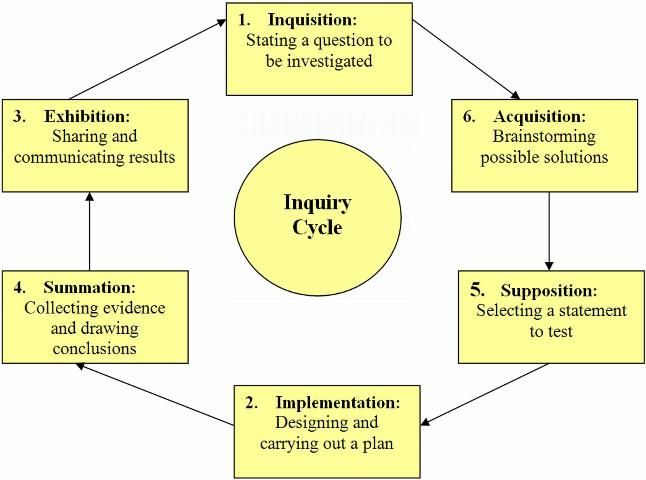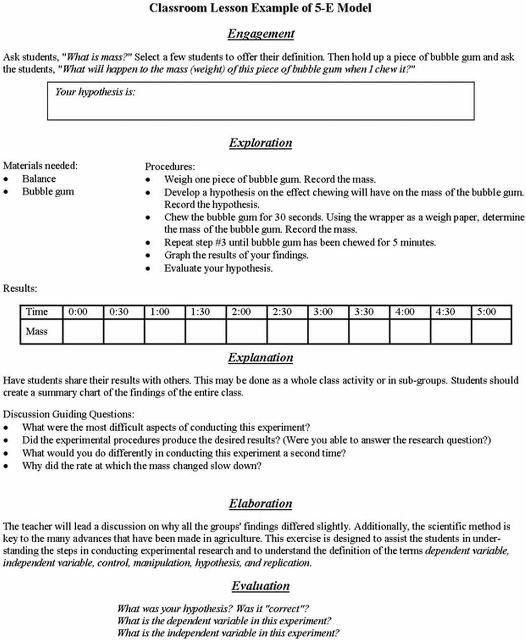Introduction
Much like a woodworker continually acquires new tools to perform different tasks in his shop, educators, too, should search for tools to add to their repertoire of educational practices. One tool is not sufficient to do every task a woodworker must complete, and one teaching method should not be considered sufficient for teaching all topics and meeting all standards. Inquiry-based teaching methods provide agricultural educators with another teaching technique for developing life-long learners. They prove especially useful in delivering concepts that rely heavily on science. This paper builds on the publication What Is Inquiry-Based Learning? by focusing on the nature of inquiry and providing basic guidelines and strategies for implementing inquiry-based teaching methods.
How Can Inquiry-Based Teaching Be Implemented?
Teachers play a vital role in adapting the inquiry process to the knowledge and ability level of their students. When using inquiry-based lessons, teachers are responsible for
- starting the inquiry process;
- promoting student dialog;
- transitioning between small groups and classroom discussions;
- intervening to clear misconceptions or develop students' understanding of content material;
- modeling scientific procedures and attitudes; and,
- utilizing student experiences to create new content knowledge.
Based on the objectives of the lesson and the abilities of the students, teachers must decide how much guidance they will provide. Regardless of the amount of assistance that teachers provide, the fundamental goal of inquiry is student engagement during the learning process.
When incorporating inquiry-based methods into the classroom, educators should ensure that each of the six stages of the inquiry cycle, as shown below, is complete.
Six Stages of the Inquiry Cycle
- Inquisition—stating a "what if" or "I wonder" question to be investigated
- Acquisition—brainstorming possible procedures
- Supposition—identifying an "I think" statement to test
- Implementation—designing and carrying out a plan
- Summation—collecting evidence and drawing conclusions
- Exhibition—sharing and communication results (Llewellyn, 2002, p. 13–14)
The inquiry cycle is illustrated further in Figure 1.

Carin, Bass, & Contant (2005) provide two models for inquiry instruction (Models 1 and 2). A sample classroom lesson plan follows in Figure 2.

Model 1: Inquiry Instruction Model—Guided Discovery
Guided Discovery
In this model, students are given concrete materials and questions. In order to answer the questions, students work individually or in small groups to explore, observe, and discover answers. The teachers can then expand upon the discoveries the students make to provide explanation of the discovery and instruction.
Preparation
Teachers must develop important questions for which they want students to search for the answers to start the lesson. They must also design activities which will allow students to discover or obtain the necessary experiences for the basis of the lesson. Finally, the teacher must gather and prepare the materials for the lesson.
Strategies
When using guided discovery, student discovery should begin as soon as possible. Teachers should give a brief introduction and quickly distribute the materials. While the students are involved in the discovery process, the teacher should move throughout the room and provide limited assistance to ensure that students don't become too frustrated and quit. Teachers may provide direction by asking questions or giving hints. Teachers should encourage classroom discussion throughout the process but refrain from giving the "right" answer.
Model 2: Inquiry Instruction Model—The 5-E Model
5-E Model
The 5-E model focuses on the five phases of engagement, exploration, explanation, elaboration, and evaluation. This model shares features with guided discovery, and many lessons can be adapted to either instructional model. Teachers can use the 5-E model to meet objectives and deliver specific concepts and explanations. This model also follows a step-by-step progression, where each step builds on the previous step.
Engagement
The first step serves as an interest approach or motivator. It builds curiosity and provides direction for the remainder of the lesson. During this stage the question for investigation is developed, prior knowledge is activated, and procedures, rules, and safety precautions are outlined. Students should be able to immediately transition into the exploration phase.
Exploration
This stage imitates guided discovery. Students manipulate the materials, make discoveries, and share their findings with classmates and the teacher. The teacher provides scaffolding by observing, questioning, and guiding. Exploration provides concrete experience from which student learning and knowledge can build.
Explanation
In this stage teachers invite their students to share their discoveries and explanations. Based on the descriptions provided by the students, teachers introduce relevant concepts, principles, and/or theories. Teachers should encourage students to make connections to their experiences during the exploration phase. Together, students and teachers utilize the concept and the experiences to describe and explain the phenomenon and answer the initial question.
Elaboration
Elaboration allows students to create connections between new concepts, principles, theories, and real-world experiences by applying them to a new situation. The application of this new knowledge provides an opportunity for students to move beyond memorization to deeper understanding of what they have learned. Small group and classroom discussions continue to play a vital role in the learning process by allowing students to share and defend their understandings and explanations.
Evaluation
Evaluation provides teachers an opportunity to assess students' knowledge and provide feedback on performance. Informal assessment and feedback may be provided throughout the inquiry learning process to reassure, encourage, or direct students. Formal assessments, such as tests or projects, provide the teacher with feedback and allow them to determine how much the students have learned from the activity. Students should also be encouraged to utilize self-assessment throughout the learning process.
Conclusion
Inquiry-based teaching methods provide agricultural educators with another tool to add to their toolbox of educational practices. Educators can use this method to capitalize on the naturally inquisitive behaviors of students. When learning through inquiry approaches, students should engage in each element of the inquiry cycle and extend their knowledge to different situations. While completing inquiry-based lessons, students develop important skills that will help them become successful, lifelong learners.
Useful Resources
Budnitz, N. (2000). What do we mean by inquiry. Retrieved January 21, 2008, from http://www.biology.duke.edu/cibl/inquiry/what_is_inquiry.htm
Carin, A. A., Bass, J. E., & Contant, T. L. (2005). Methods for teaching science as inquiry (9th ed.). Upper Saddle River, NJ: Pearson Prentice Hall.
Hebrank, M. (2000, August). Why inquiry-based teaching and learning in the middle school science classroom? Retrieved January 21, 2008, from http://www.biology.duke.edu/cibl/inquiry/why_inquiry_in_ms.htm
Llewellyn, D. (2002). Inquire within: Implementing inquiry-based science standards. Thousand Oaks, CA: Corwin Press.
Llewellyn, D. (2005). Teaching high school science through inquiry: A case study approach. Thousand Oaks, CA: Corwin Press.